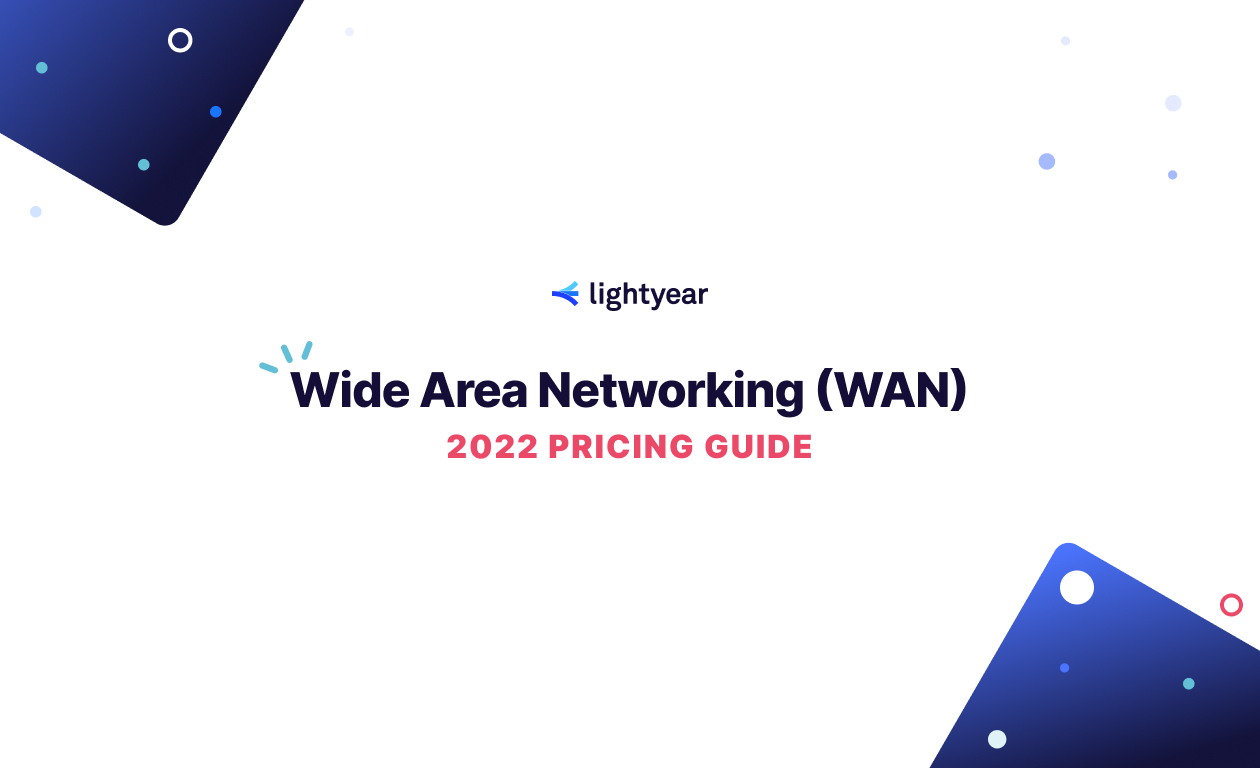Dedicated Internet Access (DIA): Ultimate 2023 Pricing Guide
Many factors impact how your dedicated internet access (DIA) connections are priced. Lightyear is pleased to share our 2023 ultimate guide to DIA pricing.
KEY TAKEAWAYS
50,000+ Service Quotes
Analyzed to produce the following pricing insightsData Integrity
Dataset thoroughly vetted by Lightyear experts1,200+ Telecom Vendors
Largest roster of telecom providers surveyed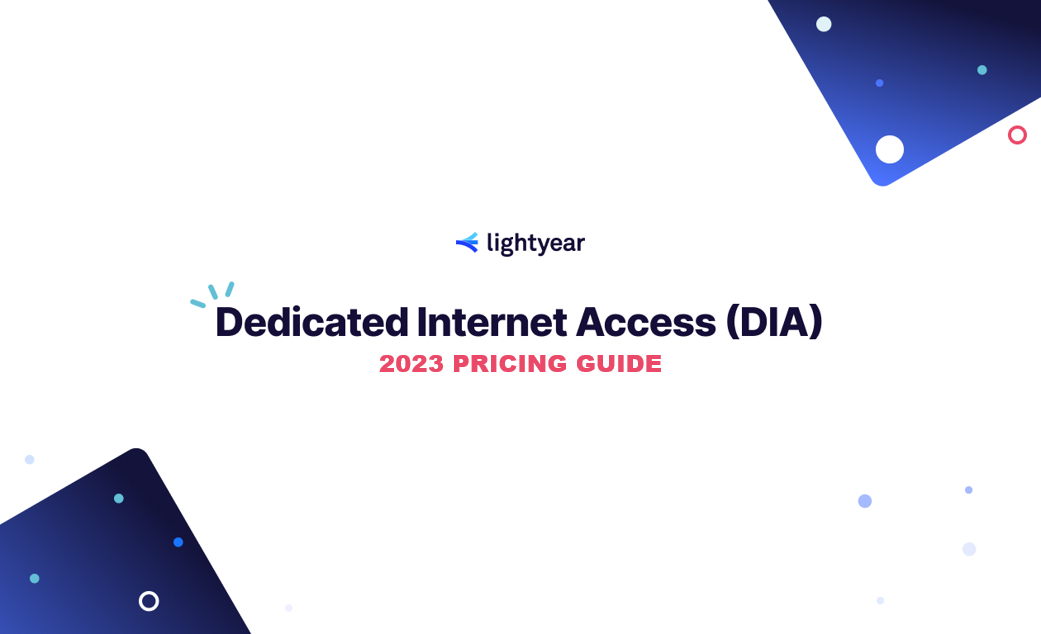
Dennis Thankachan
Apr 11, 2023
SHARE
The definition of a commodity is “a basic good used in commerce that is interchangeable with other goods of the same type”. While internet access was a novel service in the 1990s, even then, transmitting bits on a wire at varied speeds is and has always been commodity-like, with a few core variables impacting the commodity's price: speed, bandwidth, transport, local competitive dynamics and more. At the end of the day, you likely don't care who your ISP is, you just care that you have reliable internet access at a given speed.
However, if it's true that internet access is commodity-like, shouldn't it be priced like one, with limited variance as you tweak specific variables that impact price? Unfortunately, it's not. In evaluating the data across thousands of price quotes, you can see a high degree of variance in dedicated internet pricing delivered to businesses.
Telecom service providers take advantage of the lack of transparency on pricing in the space to get away with pricing their services as if they are not commodities. In fact, it’s not uncommon to receive vastly different quotes from the same provider for the same service when quoting within the same building. You heard that right!
It is to correct for these issues that we expose DIA pricing data annually in this report (and also work on the product that is Lightyear). Read on to better understand - how are internet services priced, what should you expect to pay for your services, and why is the internet pricing landscape so opaque?
Dedicated (DIA) vs. Best Effort Internet Connections
Before we dive into the details of what impacts your internet pricing, we are going to compare best effort internet access to dedicated internet access (DIA) - the biggest determining factor in the quality and cost of your internet connection.
Best Effort Internet
Best effort internet connectivity is likely what you utilize in your home. With a best effort internet connection, your bandwidth is shared amongst a group of customers. This means that if both you and your next door neighbor like to stream Netflix after dinner, you will experience traffic congestion if the carrier has not allocated enough bandwidth for the group.
It’s also worth noting that best effort internet is marketed at maximum speeds, meaning if you have a “100 Mbps connection”, that’s the very best speed you’ll get and in reality it will likely be lower (or much lower, depending on the network traffic).
Best effort connections also often are served up with “asymmetrical bandwidth”, meaning that your download speeds are faster, often significantly faster, than your upload speeds. They are quoted as “download Mbps / upload Mbps”, so a “10/3” connection means you have 10 Mbps of download bandwidth and 3 Mbps of upload bandwidth.
Dedicated Internet Access (DIA)
But what if you’re doing work that is a bit more mission critical than catching a rerun of Frasier? That’s where dedicated internet access (DIA) comes in. With DIA, the bandwidth is all yours (no sharing!), symmetric (same upload and download speeds), and guaranteed by the Internet Service Provider (ISP). In fact, a DIA connection will come with several Service Level Agreements (SLAs) that guarantee the uptime of your network >99.9% of the time, or your money back. DIA has a few other nicknames, such as dedicated fiber, dedicated ethernet, fast ethernet, ethernet over fiber, dedicated fixed wireless, or ethernet over copper / T-1 / T-3 if you’re an old school networker. DIA is often considered the "gold standard" for a business's primary internet connection.
Who needs DIA? Well for one, any business that doesn’t want to (or can’t) pay the price of network downtime would benefit from SLAs that come with a DIA connection. Further, data intensive work environments where you are sharing lots of large files or utilizing video, voice-over-internet-protocol (VOIP), and unified communications as a service (UCaaS), dedicated internet can make or break your company’s performance. Latency could be the difference between a successful sales pitch or an unhappy customer.
Now that we’ve gone over the key differences between dedicated and best effort internet, let’s dive into how these services are actually priced.
How are Dedicated Internet and Best Effort Internet Services Priced?
Factors that impact your internet pricing include:
Dedicated vs. Best Effort
Best effort internet connectivity is often significantly cheaper than dedicated internet access. DIA connections are individually provisioned, typically involve at least a little construction, come with specialized support, and are backed by various guarantees on performance. When utilizing DIA, your carrier will provide a service level agreement (SLA) that guarantees connection quality 99%+ of the time, including network uptime, latency, jitter, and packet-loss.
If a network provider is not meeting their SLAs, you are legally guaranteed a refund or service credits and can sometimes even end your contract over the matter.
Different carriers provide different SLA guarantees, almost all in the 99%+ uptime range. Some providers boast an extra “9” or so in their SLA guarantee (“99.9999%”... whatever you say), but they’re all virtually the same.
What does all of this add up to? Higher cost for dedicated connectivity (that is justified most of the time).
Bandwidth
Bandwidth is the amount of data that your network can transmit in a given unit of time. As your bandwidth requirements increase, so does the cost of your telecom services. More bandwidth requires more infrastructure capacity to be provisioned by your ISP, which of course costs money. All else equal, more bandwidth = more expensive connectivity.
With regard to dedicated internet access, your bandwidth comes in two flavors: fixed bandwidth and burstable bandwidth.
Fixed bandwidth is pretty self explanatory as it refers to a connection where your bandwidth or capacity is set in stone. If at any moment your network attempts to transmit more data than your limit, you’ll hit a wall and your data packets will be dropped, so fixed bandwidth makes sense for a business that doesn't anticipate much variance in ongoing bandwidth needs.
Burstable bandwidth refers to a network that allows for normal bandwidth utilization up to a certain capacity, but in the event that you require higher capacity you are able to “burst” that cap and utilize more bandwidth as needed. The catch is (of course there is a catch) that utilization above your burst cap costs more.
All else equal, burstable bandwidth's monthly fixed cost will be lower than that of fixed bandwidth, but which one is cheaper for you will depend on how often you burst your utilization cap and by how much. The incremental cost of burstable bandwidth when above the burst cap is high, so this will average up your bill's costs. At a minimum, you're likely to see much more month to month billing variance with burstable bandwidth. If you anticipate higher variance in bandwidth needs month-to-month and can stomach differences in monthly billing, burstable bandwidth might be better for you.
Speed/Latency
Internet speed, or latency, refers to how much time it takes for a signal to travel to its destination and back across your network. When you ask a question on Google, your device sends a signal to the server to retrieve your answer and brings it back to you; latency measures the delay between when you ask the question on your device and when you see the answer.
Connection Quality
Connection quality is measured by latency (as mentioned above), jitter and packet loss. Jitter is when data packets arrive at different times, resulting in delayed audio or video. Packet loss is when packets don’t arrive, arrive out of order, or arrive too late, leading to choppy and low quality connections.
As discussed further in the SLA section, DIA allows you to source a circuit that has quality guarantees around packet loss and jitter.
On-Net vs. Off-Net
A key factor driving the cost of your DIA connection is if it requires the carrier to spend money to physically build the connection. If a build is required, the carrier will deem themselves “off-net” or “not lit” at a given location, and likely price the link at a much higher monthly cost to cover the build costs. “On-net” or “lit” connections are cheaper, as they do not require a build to service. Generally speaking, if a provider has fiber within 500 feet of a location, they are “near-net”. This is part of why on-net vs off-net order pricing is so nuanced. A build of 500 feet costs much less than a build of a few miles.
If you require Lumen DIA in a building where Lumen already has fiber connectivity, then this connection is on-net and will cost less than an off-net DIA connection. However, if you want to procure a circuit from AT&T at a location where it isn’t already built into the network, your service will be much more costly due to the capital expenditures required by the provider to service you. That capital expenditure will either be charged as your non-recurring cost (NRC) or will be amortized over your monthly recurring cost (MRC). If you're off-net and need your installation in a shorter time period than the "standard install interval", you might be faced with an expedite fee.
Build costs are a big part of why it is so hard to procure DIA for personal use, as carriers don’t have fiber running into every home on the block.
In a Data Center
Internet connectivity is always cheaper when in a colocation data center. This is due to the fact that data centers often have many ISPs on-net who are connected to hefty backhaul pipes, so they can provide bandwidth on the cheap without construction needed.
Local Competition
Similar to the previous point on data center connectivity, the amount of local competition in your regional market for business internet can impact the pricing for your internet services. If you live in a dense urban area with a large LEC and multiple tier 1/2 providers, you should be able to procure your services for less, again due to the principles of supply and demand.
While the in-home best effort broadband market has been cornered by behemoths such as Comcast, AT&T, Verizon, and Spectrum, the business internet market is actually less of a monopoly.
Carrier Managed Router / No Router
Funnily enough, you don’t really need a carrier managed router anymore because carriers deliver ethernet based services, which are universal protocols that run on both sides of the firewall. Whereas before, the generation of access was proprietary signaling that required a CSU/DSU.
Additionally, many carriers (especially the large ones) cannot *easily* add or provide a router. For them, it adds a layer of complication for service delivery and an added cost that in most cases simply is not worth it. If you cannot terminate your circuit into an existing layer 2 or 3 device on your LAN, our suggestion is to go out and buy your own router and forgo the carrier managed route.
Sometimes you do crazy stuff and need a carrier provided router, but these instances are few and far between.
Your Provider
We’d be remiss not to mention that the actual telecom provider you are sourcing from can have an impact on the cost of your internet connectivity. Pretty odd for a commodity service, right? We actually wrote a blog on this calamity, check it out: Is Internet Connectivity a Commodity?
Redundancy
Whether your network is redundant or not does not impact the cost of the circuit you are procuring, however we wanted to take this opportunity to plug just how important network redundancy is.
Redundant circuits are the name of the game if you want to maximize network uptime, employee productivity, and customer satisfaction. A redundant circuit won’t always cost you as much as your primary circuit - you can procure lower cost options that are either less reliable, less capable, or have a different billing structure where you pay by utilization. This is how 5G redundant circuits are billed.
Lightyear’s Telecom Pricing Data
Get to it already! What does a DIA circuit cost? Below, we’ll share pricing data across a slew of internet access variations sourced from our proprietary pricing data set. Before we get into it, here are a few notes on our data set to help you understand what you’re looking at.
Our data set includes ~50k quotes served over the past years and has been scrubbed for outliers
In instances where we show a highest and lowest observation, the quotes displayed most often represent abnormal cases that should not be expected and go to exhibit the huge variance and uncertainty you will see in telecom pricing.
We partner with 1,200+ providers and our data set includes connectivity quotes from all major carriers, and many regional carriers as well
Quotes are distributed all around the US (with some international metros also accounted for), with no heavy regional bias. However, they do typically fall in urban areas. Geography, in most cases, doesn't have a huge impact on pricing.
Dedicated Internet Pricing
DIA Pricing by Bandwidth
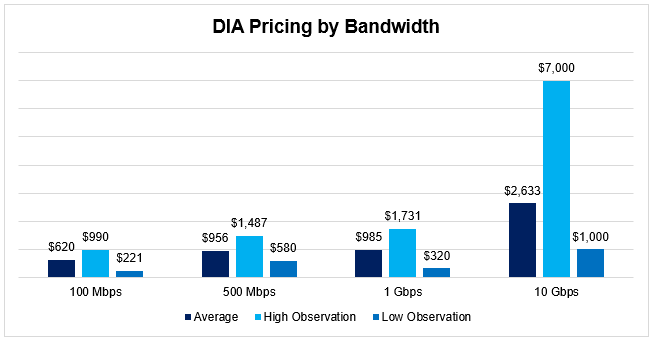
Fixed bandwidth DIA, on-net building, 36 month term, non-managed router
Unsurprisingly, the data here exhibits how higher bandwidth leads to higher costs. However, interestingly enough, MRC does not scale with bandwidth. The 500Mbps average price is less than double that of 100Mbps, the 1Gbps price is not way off from the 500Mbps price, and the 10Gbps price is ~2.6x that of 1Gbps. Note that all of the above pricing reflects “on-net” pricing. “Off-net” pricing would cost significantly more, and connectivity in a data center will be cheaper than not (more on both of these factors below).
As a general guide, any 500Mbps+ DIA circuit at sub-$1k / month is a solid price (when not in a data center).
Lit vs Not Lit Building aka On-Net vs Off-Net
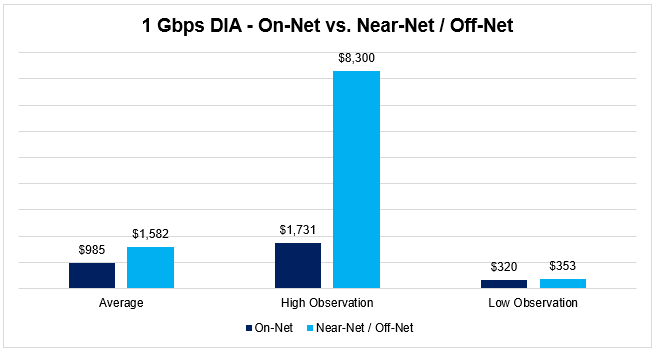
1Gbps DIA, not in data center, fixed bandwidth, 36 month term, non-managed router
As you can see, when you are sourcing DIA in a lit building or “on-net” building, it will always cost less than when you are sourcing in an un-lit / off-net building. This is due to the build cost that is required when a carrier is not already on-net in a building.
Note that the highest observation for off-net DIA of $8,300 is due to a build cost being amortized over the life of the contract. In some cases that fee will be captured in the non-recurring cost (NRC). Also, this data set is scrubbed for a few crazy off-net outliers, where some carriers quoted a $20k+ MRC - what were they building, the Taj Mahal?
Contract Length
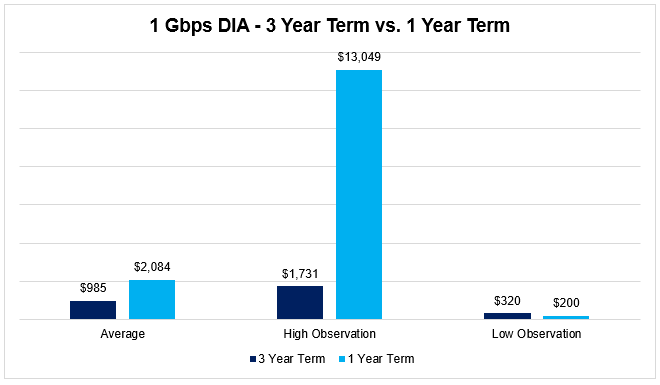
1Gbps DIA, not in data center, fixed bandwidth, on-net building, non-managed router
Generally speaking, longer term contracts are often priced more favorably than shorter term contracts due to the simple fact that carriers can amortize their build / install costs over a longer period of time. Most contracts we see are signed on a 36-month term.
Conclusion
We hope this post helped shed some light on how dedicated internet services are priced. If you made it this far, you’re aware that quite a few factors go into your internet quotes and some orders are more nuanced than others.
Despite the nuance, here at Lightyear we believe that connectivity is a commodity and it should accordingly be procured and managed like one.
We are working round the clock to mine our data for helpful insights like these. We hope to use our data to help get businesses the value they deserve.
If your enterprise needs help procuring, implementing, managing, or rebidding your telecom services, don’t hesitate to reach out for a demo of our services.
Featured Articles
Not ready to buy?
Stay up to date on our product, straight to your inbox every month.


